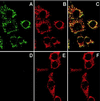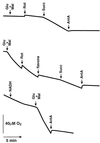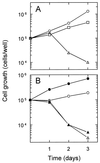Molecular remedy of complex I defects: rotenone-insensitive internal NADH-quinone oxidoreductase of Saccharomyces cerevisiae mitochondria restores the NADH oxidase activity of complex I-deficient mammalian cells
- PMID: 9689052
- PMCID: PMC21310
- DOI: 10.1073/pnas.95.16.9167
Molecular remedy of complex I defects: rotenone-insensitive internal NADH-quinone oxidoreductase of Saccharomyces cerevisiae mitochondria restores the NADH oxidase activity of complex I-deficient mammalian cells
Abstract
The NDI1 gene encoding rotenone-insensitive internal NADH-quinone oxidoreductase of Saccharomyces cerevisiae mitochondria was cotransfected into the complex I-deficient Chinese hamster CCL16-B2 cells. Stable NDI1-transfected cells were obtained by screening with antibiotic G418. The NDI1 gene was shown to be expressed in the transfected cells. The expressed Ndi1 enzyme was recognized to be localized to mitochondria by immunoblotting and confocal immunofluorescence microscopic analyses. Using digitonin-permeabilized cells, it was shown that the transfected cells, but not nontransfected control cells, exhibited the electron transfer activities with glutamate/malate as the respiratory substrate. The activities were inhibited by flavone, antimycin A, and KCN but not by rotenone. Added NADH did not serve as the substrate, suggesting that the expressed Ndi1 enzyme was located on the matrix side of the inner mitochondrial membranes. Furthermore, although nontransfected cells could not survive in a medium low in glucose (0.6 mM), which is a substrate of glycolysis, the NDI1-transfected cells were able to grow in the absence of added glucose. When glycolysis is slow, either at low glucose concentrations or in the presence of galactose, respiration is required for cells to survive. The mutant cells do not survive at low glucose or in galactose, but they can be rescued by Ndi1. These results indicated that the S. cerevisiae Ndi1 was expressed functionally in CCL16-B2 cells and catalyzed electron transfer from NADH in the matrix to ubiquinone-10 in the inner mitochondrial membranes. It is concluded that the NDI1 gene provides a potentially useful tool for gene therapy of mitochondrial diseases caused by complex I deficiency.
Figures




Similar articles
-
Rotenone-insensitive internal NADH-quinone oxidoreductase of Saccharomyces cerevisiae mitochondria: the enzyme expressed in Escherichia coli acts as a member of the respiratory chain in the host cells.FEBS Lett. 1998 Jan 2;421(1):37-40. doi: 10.1016/s0014-5793(97)01533-0. FEBS Lett. 1998. PMID: 9462835
-
Modulation of oxidative phosphorylation of human kidney 293 cells by transfection with the internal rotenone-insensitive NADH-quinone oxidoreductase (NDI1) gene of Saccharomyces cerevisiae.Biochim Biophys Acta. 1999 May 26;1412(1):56-65. doi: 10.1016/s0005-2728(99)00051-1. Biochim Biophys Acta. 1999. PMID: 10354494
-
Lack of complex I activity in human cells carrying a mutation in MtDNA-encoded ND4 subunit is corrected by the Saccharomyces cerevisiae NADH-quinone oxidoreductase (NDI1) gene.J Biol Chem. 2001 Oct 19;276(42):38808-13. doi: 10.1074/jbc.M106363200. Epub 2001 Jul 30. J Biol Chem. 2001. PMID: 11479321
-
NADH dehydrogenases: from basic science to biomedicine.J Bioenerg Biomembr. 2001 Jun;33(3):233-42. doi: 10.1023/a:1010787004053. J Bioenerg Biomembr. 2001. PMID: 11695833 Review.
-
Possibility of transkingdom gene therapy for complex I diseases.Biochim Biophys Acta. 2006 May-Jun;1757(5-6):708-14. doi: 10.1016/j.bbabio.2006.01.011. Epub 2006 Feb 24. Biochim Biophys Acta. 2006. PMID: 16581014 Review.
Cited by
-
Structural insight into the type-II mitochondrial NADH dehydrogenases.Nature. 2012 Nov 15;491(7424):478-82. doi: 10.1038/nature11541. Epub 2012 Oct 21. Nature. 2012. PMID: 23086143
-
The mitochondrial alcohol dehydrogenase Adh3p is involved in a redox shuttle in Saccharomyces cerevisiae.J Bacteriol. 2000 Sep;182(17):4730-7. doi: 10.1128/JB.182.17.4730-4737.2000. J Bacteriol. 2000. PMID: 10940011 Free PMC article.
-
Identification of the Highly Active, Species Cross-Reactive Complex I Inhibitor BAY-179.ACS Med Chem Lett. 2022 Feb 18;13(3):348-357. doi: 10.1021/acsmedchemlett.1c00666. eCollection 2022 Mar 10. ACS Med Chem Lett. 2022. PMID: 35300083 Free PMC article.
-
Differential Effects of Yeast NADH Dehydrogenase (Ndi1) Expression on Mitochondrial Function and Inclusion Formation in a Cell Culture Model of Sporadic Parkinson's Disease.Biomolecules. 2019 Mar 27;9(4):119. doi: 10.3390/biom9040119. Biomolecules. 2019. PMID: 30934776 Free PMC article.
-
Petasin potently inhibits mitochondrial complex I-based metabolism that supports tumor growth and metastasis.J Clin Invest. 2021 Sep 1;131(17):e139933. doi: 10.1172/JCI139933. J Clin Invest. 2021. PMID: 34623325 Free PMC article.
References
-
- Chomyn A, Mariottini P, Cleeter M W J, Ragan C I, Matsuno-Yagi A, Hatefi Y, Doolittle R F, Attardi G. Nature (London) 1985;314:591–597. - PubMed
-
- Chomyn A, Cleeter M W J, Ragan C I, Riley M, Doolittle R F, Attardi G. Science. 1986;234:614–618. - PubMed
-
- Hatefi Y. Annu Rev Biochem. 1985;54:1015–1069. - PubMed
-
- Yano T, Chu S S, Sled’ V D, Ohnishi T, Yagi T. J Biol Chem. 1997;272:4201–4211. - PubMed
Publication types
MeSH terms
Substances
Grants and funding
LinkOut - more resources
Full Text Sources
Other Literature Sources
Molecular Biology Databases

